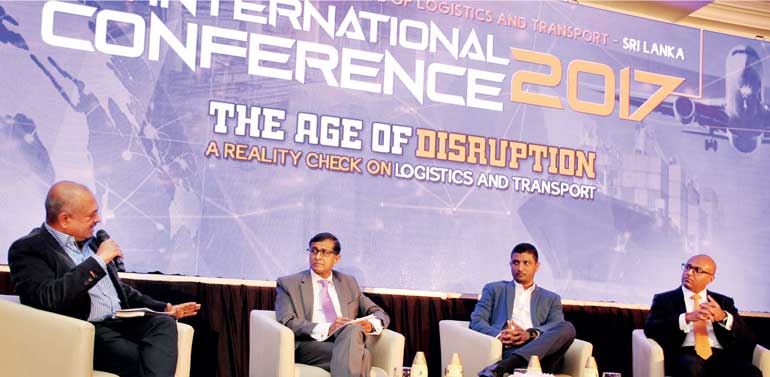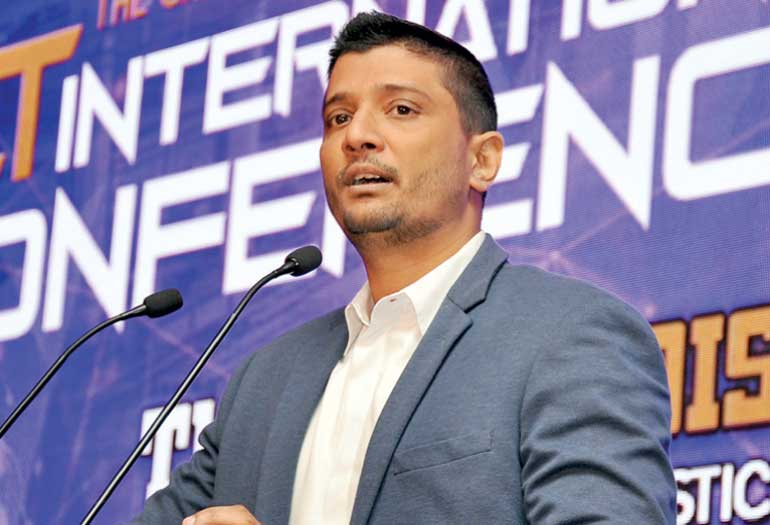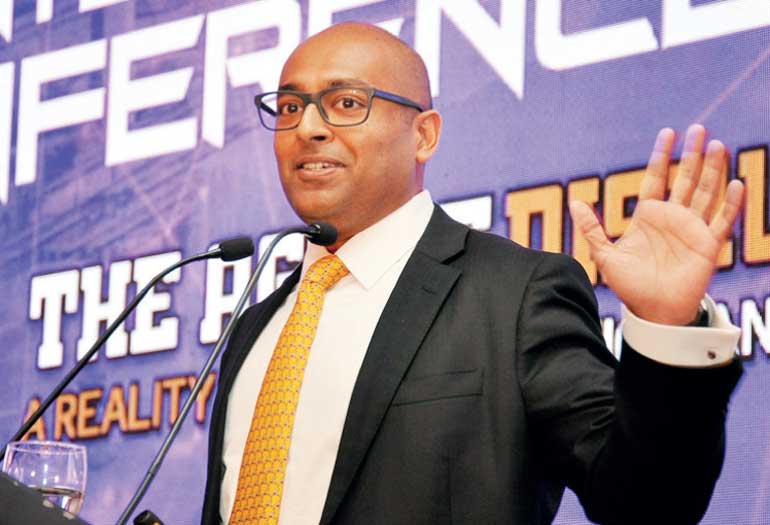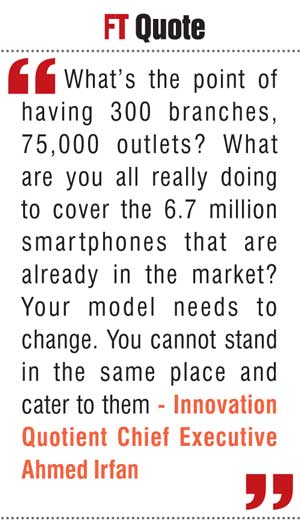Wednesday Dec 03, 2025
Wednesday Dec 03, 2025
Monday, 23 October 2017 00:00 - - {{hitsCtrl.values.hits}}

Speaking on next generation supply chains, Innovation Quotient Chief Executive Ahmed Irfan gave an in-depth assessment of how disruption from a consumer, the market and logistics could lead to last mile success, where it was possible to really turn the world upside down.
Claiming that he was no expert in transport and logistics, he said his passion was to map what was happening with the consumer, consuming products and eventually how businesses get products across to their clients.
“It is really hard to get a sense of, draw lines, as it is mostly driven by the rapid rate of technology that is driving us. The digital could be called the culprit as well as the instigator at the same time,” he added.
Citing a study conducted by Deloitte, he underscored four key areas of industry ripe for disruption which include short-fuse big bang, short-fuse small bang, long-fuse big bang and long-fuse small bang. Accordingly, retail, banking insurance, real estate, professional services, education and media were categorised under short-fuse big bang which is taking place now.
“For example, if you are a banker your traditional competition would be another commercial bank but my biggest threat today is none of them — it would be the highest penetrated mobile company in Sri Lanka that has 10.3 million customers and each one is a potential candidate for mobile banking. With the rate of smartphone penetration today, that is really a threat for banks. Sri Lankans watch 17 hours of YouTube monthly, that’s 40 minutes per day, where 67% of them are mobile and 30% are watching online on YouTube. Primetime news and dramas are not relevant anymore. So if you are right now in the media industry, you are facing a crisis. Every industry in the short-fuse big bang category is now facing this threat. So it could be an opportunity or a threat.”
Revealing that there were around seven million Facebook accountholders in Sri Lanka and Facebook in partnership with another platform called Shopify recently launched a Facebook ‘buy button’, Irfan said this has essentially turned every Facebook accountholder into an ecommerce customer.
“What’s the point of having 300 branches, 75,000 outlets? What are you all really doing to cover the 6.7 million smartphones that are already in the market? Your model needs to change. You cannot stand in the same place and cater to them,” he pointed out.

Innovation Quotient Founder Chief Executive Ahmed Irfan
He said logistics is in the long-fuse big bang category under transportation which pretty much covers the sector. “Logistics is stuck in changes happening between retail space and disruption happening in the transportation space. The medium of transport is changing, technology driving transport is changing and therefore the whole industry is being recalibrated.” It was pointed out that according to a global research study conducted on consumers and the impact on digital consumers, 81% of purchases were influenced by social media, 73% of consumers shop in over five channels, 26% of consumers are loyal and 41% of consumer goods companies sell direct.
While calling for the recognition of 3D printing, drones, robotics and automation, self-driven vehicles, big data, self-learning systems and AI as trends and developments, he questioned if companies were going to focus on trends or shift as there was a big difference between the two.
“Trends are cool, it is popular, it has a lot of inventive power, but what makes shift more important is it starts impacting human behaviour. It starts creating a sustainable business model behind and it starts creating value,” he explained.
Elaborating on DHL’s trends radar, which has quite successfully matched the shifts and trends that are to be faced in five years and beyond, Irfan asserted that on-demand and omni channels will be the main shift.
He further noted that after China, South Asia was the largest spending consumer and it was therefore important to focus on catering to that massive demand.
Self-driven vehicles, digital identifiers and shared economic logistics were outlined as shifts beyond the five-year horizon.
“Shifts will always be true,” he said.
Focus on shits
The four key pillars of shifts include the democratisation of e-commerce, asset centric vs. asset optimisation, actionable data not big data and the battle for the last mile.
Irfan said Sri Lanka’s e-commerce market was poised to be worth Rs. 30 billion by 2020 from its current Rs. 4 billion.
“Today the consumer is far more advanced than us, and we have not really kept up,” he stressed. However, he emphasised that despite having an abundance of e-commerce platforms, all of the players still need to depend on somebody else getting the products across to the customer.
Further, it was noted that in today’s context a lot of these fulfilment platforms were starting to get self-orchestrated mechanisms such as Amazon.com and Simplex.com where last mile logistics were trackable.
“E-commerce and consumer disruption alone are not good enough; fulfilment needs to match up to it. That’s how e-commerce is moving into the digital era,” he added. In terms of asset optimisation, Sri Lanka Post has 652 post offices with 15,000 postmen who can visit every home daily, but sadly it has become a highly underutilised and underleveraged asset. Therefore, he urged to make use of this service.
“We don’t have to earn everything in today’s business model. It’s about how you collaborate with partners and aggregate every asset on the platform used to reach your consumers fast,” he asserted.
Emphasising that success mostly depends on business models, Irfan said a digital supply network would assist firms to win that last mile race in the highly competitive marketplace. “In Sri Lanka, data discipline is very low. What you need is not big data, but rather actionable data.”
He said Amazon.com has now moved on to same-hour delivery based on data they have collected about their customers. The firm has launched anticipatory shipping, where it ship goods to the closest place and the moment a consumer clicks, it reaches that consumer within an hour.
“This is predictive analysis. This is not big data, but actionable data. In a small market like Sri Lanka, this is an ideal environment to pilot concepts of this nature.”

Create Lab Co-Founder and CEO Thilan Wickramasinghe
Battle for the last mile
Hayleys’ recent buyout of Singer was identified as a brilliant case study of retail and fulfilment. He suggested partnerships of this nature add inventory, consumer discovery and consumer fulfilment.
“Battle for the last mile is not about how you get to your customer, but to get the products he wants in the way he prefers. Look at the deal assets, leverage, build a circle around the consumer and that’s how the last mile battle works. It is about how you can connect consumer sentiments and consumer discovery to the last mile.”
He said by connecting all four pillars together, there will be disruptive models and not disruptive technologies. “Technology is only an enabler, but it is really about technology optimisation within the business.”
“Connect the dots, enable collaboration, optimise technology and focus on shifts. You are brilliantly positioned in retail, technology, logistics revolution. Look at the trends, understand the shifts according to your business model and start small because the best way to predict the future is to create it yourself,” Irfan stressed.
Emerging technologies in transportation and logistics
Elaborating on emerging technologies in transportation and logistics, Create Lab Co-Founder and CEO Thilan Wickramasinghe said as the world was in the age of the fourth industrial revolution, a child in Sub-Saharan Africa had access to more information than he has access to safe drinking water, food or sanitation.
“By the time a primary school child today enters the workforce, technology will be 300 times more powerful. Hence, the line between industries and technology is getting blurred and blurred. Disruption to white collar jobs is already here as computers have taken over many blue collar jobs.”
It was pointed out that supply chain challenges grow in the 21st Century, with the world population expected to reach nine billion by 2050, omni channel consumers set to rise with four billion smartphone users, short product life-cycles, the emergence of global platforms, protectionism and the electric economy.
Elaborating on transport and logistics disruptors that include robotics, IOT and Blockchain, smart manufacturing, AI and Big Data as well as sustainable logistics, he emphasised each sector’s trends and the impact on the industry.
Wickramasinghe outlined control towers and platform providers, transaction automation, smaller warehousing and fewer jobs as major trends in the transportation and logistics industry. “Increasingly, standalone systems, ERPs in supply, manufacturing, logistics and transportation will be integrated to singular dashboards where AI will play a major role in the management of the flow of goods and information,” he added.
In terms of transaction automation, he pointed out that barriers to trust will be reduced with Blockchain technology, where verified ‘one truth’ will facilitate transactions at each link of the supply chain while these smart contracts linked to the Blockchain will auto-execute payments.
“This will have a significant negative impact on brokerage, facilitation, and middle man value-added services,” Wickramasinghe pointed out.
Stating that global firms that are maintaining robotic warehouse operations will reduce large floor area requirements, he insisted that automated fleets can keep the warehouse stocked with the right goods at the right time consistently.
 “Smart manufacturing will reduce inventory requirements and production can be scaled more accurately to respond to demand,” he said.
“Smart manufacturing will reduce inventory requirements and production can be scaled more accurately to respond to demand,” he said.
Noting that automation across the supply chain will impact many routine, repetitive, process-driven jobs, Wickramasinghe asserted that there will be demand for technology-related marketing, data science, remote piloting and digital contract structuring jobs that require problem-solving skills.
Rewards for risk-takers
While asking the audience if their firms were ready for these realities, he emphasised that there were tremendous rewards for risk-takers.
Wickramasinghe suggested building a data-driven organisation, which supports and embraces innovation, collaborates and possesses up-skill employees.
“Have a plan. Build or buy capabilities to respond to the known and known unknowns. Integrate tech-DNA across departments, facilities. Provide employees with the capabilities to take risks and solve identified bottlenecks in the organisation,” he stressed.
He pointed to launch Accelerators & Hackathons to embrace the collaborative economy by tapping into the best ideas of the public.
Acknowledging that there will be significant shortages of the right technology skills, he asked to equip employees with future skills such as coding, data science and solutions engineering that will ease the supply crunch for skills. “Retrain and retain,” he added.
Stating that there is no more ‘us vs. them’, Wickramasinghe said competition was being replaced by sharing – especially for legacy players who were asset heavy. “Share capacity.”
He said technology platforms allow new entrants to come in and scale very rapidly with minimal asset investments. “Beware of new entrants. Monitor and adopt their strategies, or even better, buy them out.”
Following the first session of presentations, a Q&A discussion was moderated by Daily FT Editor Nisthar Cassim, which comprised Lakshman Kadirgamar Institute of International Relations and Strategic Studies Global Economy Program Chair Dr. Ganeshan Wignaraja, Create Lab Co-Founder and CEO Thilan Wickramasinghe and Innovation Quotient Chief Executive Ahmed Irfan
Q: How can firms in logistics and transport manage the impact of global risks?
Dr. Wignaraja: The key is flexibility in business strategies and also to have a different type of workforce, so that you can move as the situation arises.
Q: With disruption comes the shifting of traditional business. What do you think should be the response?
Irfan: My advice is to first start sensing what’s happening out there because a lot of us have this closed-door policy. We are very insular in our thinking. I think the fundamental change that businesses can make is to stop holding on and to open up. It is really hard to create one big picture and say ‘I got the whole world figured’, that’s not going to work.
Q: How should businesses prioritise the four risks you pointed out?
Wickramasinghe: All four factors are equally important but I would say we can highlight two out of that. I would really concentrate on bringing new technology into a business’s DNA. This is a problem for supply chain companies as they have got a culture where they carry out things in ways for many years and find it difficult to change.
Innovation is another factor. It is not hard to make use of the ideas of your employees to work out on solutions. We are living in a world where there are no enemies anymore. So you have to start embracing competition, collaboration and the public to come up with solutions for you by conducting initiatives like hackathons. The impact of these types of events is significant.
Q: What’s the mindset we need to bring in collaboration and innovation within an organisation?
Irfan: There are a couple of factors. A lot of us hold on to ‘today’, but just because you do well today doesn’t mean you will do well tomorrow. You have to really cross the bridge and that requires a lot more agility. The second point is the leadership. The senior management of firms need to take up the ideas of the digital natives. The mindset will only change when you know where you are going and are able to accept failure.
Q: How does Singapore embrace all the technology in transport and logistics in their own way?
Wickramasinghe: The Singapore Government supports companies a lot in their R&D initiatives. I don’t think Singapore is the right comparison for Sri Lanka. Singapore is a very small market, with a highly corporatized Government. I think for Sri Lanka, the innovation should come from the private sector.
We have some dynamic private sector firms here but what is required for them to come up with solutions. We have seen it in the garment sector. Hence, by identifying that there’s disruption taking place. I think the private sector has to come up with innovative ideas.
Dr.Wignaraja: For Singapore to be an innovation-led country, they attracted a lot of multinational companies to the key sectors they wanted to take off. Secondly, they invested heavily in science and technology education at all levels.
Thirdly, they adopted digital infrastructure very fast. Finally, as technology-based start-ups have matured, they have created incubators. We are still at an early stage. To come up to this level, we need partnerships.
Q: Often companies complain that technology is very expensive. How do we manage the expense of technology?
Irfan: The norm of technology is very expensive is largely not true. There are enough technology platforms we can work out in collaborative ways, there are enough people out there that want to sort the same problem you want solutions for — but they are in different stages of the value chain. So one strategy is to access the best technology that other people also want to solve and collaborate. A concept like cloud has made technology very accessible.
Q: Will there be a social revolution in terms of job disruption?
Wickramasinghe: There are a lot of factors that make humans unique, including creativity, the ability to solve problems and empathise. A lot of these skills will be required in the 21st Century. Anything that’s routine, a computer can deliver much faster. AI will help you make a decision for you. Big Data will give you insights, but it won’t tell what to do with this information. It is not about losing jobs, it’s a lot about creating skilled people. This is the best time ever to skill yourself up because there are so many resources out there to learn unlike in the past.
Dr. Wignaraja: We need to accept the fact that we live in a dualism economy. There are a great number of people out there for who technology can be a problem. We need to reach out to those people. There are two ways of doing it: one is to teach the English language and the other is to teach them technology.
Sri Lanka is not shining in the digitised space; there are huge lags when you look at the statistics.
In the technology world, there is a term called universal basic income (UBI). As robots come and start disrupting technology, we need to think how the workers that will be displaced from that technology actually have another life. In Sri Lanka, the classic story that’s coming in 10 years is the ‘sewbots’. So we’ve got to think of the social changes in a much more comprehensive way.
Q: What are the strategic logistical options for apparel, especially for near-shore manufacturing? What are the impacts of 3D printing on the apparel sector?
Irfan: Of course 3D printing is making a revolution. It will have an impact on the apparel industry. It is going to have a revolution from the shop floor and have a major impact on customer experience. At present, 3D printing basically depends on the quality of polymer and comfort, proper fit are something that’s not yet sorted.
Wickramsinghe: About 20 years ago garment manufacturers’ main concern was cheap labour, but now those firms are concerned about which countries have cheap electricity — that’s where garment industries are going to go.
This shift is also getting catalysed because of nationalist policies in the consumer markets like Europe and the US. It was one reason for Sri Lankan garment manufacturers buying factories in the US, so they would be in prepared grounds. I think it will happen eventually.
Q: There’s a confidence issue because of the inconsistency of policies in terms of public-private partnerships (PPPs). Do you think PPP models can work in Sri Lanka?
Dr. Wignaraja: The Government has many policies but their communication policy framework doesn’t seem to be optimal yet. I think they’re getting a bit better with the new Finance Minister, who is also in charge of Mass Media.
The second aspect is Coalition Government politics, which is more complex. However, the National Economic Council which sits above this Cabinet Committee on Economic Management (CCEM) I believe will iron it out. I think we can work out on PPPs, but the public sector must get used to the idea of it.
On the private sector side, some large-scale projects need public guarantees, likewise when you work with multilateral donors. The private sector also needs to take long-term risks.